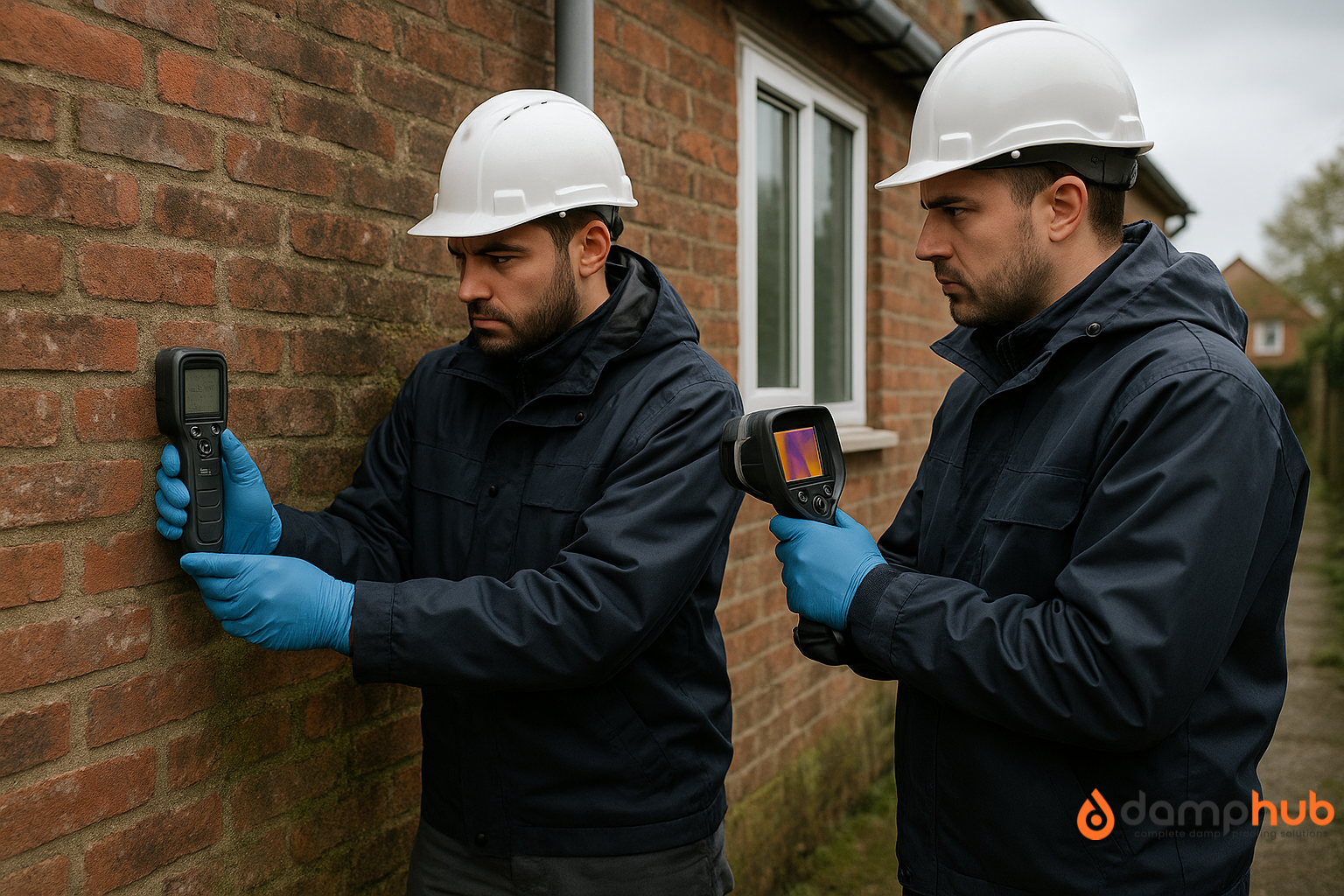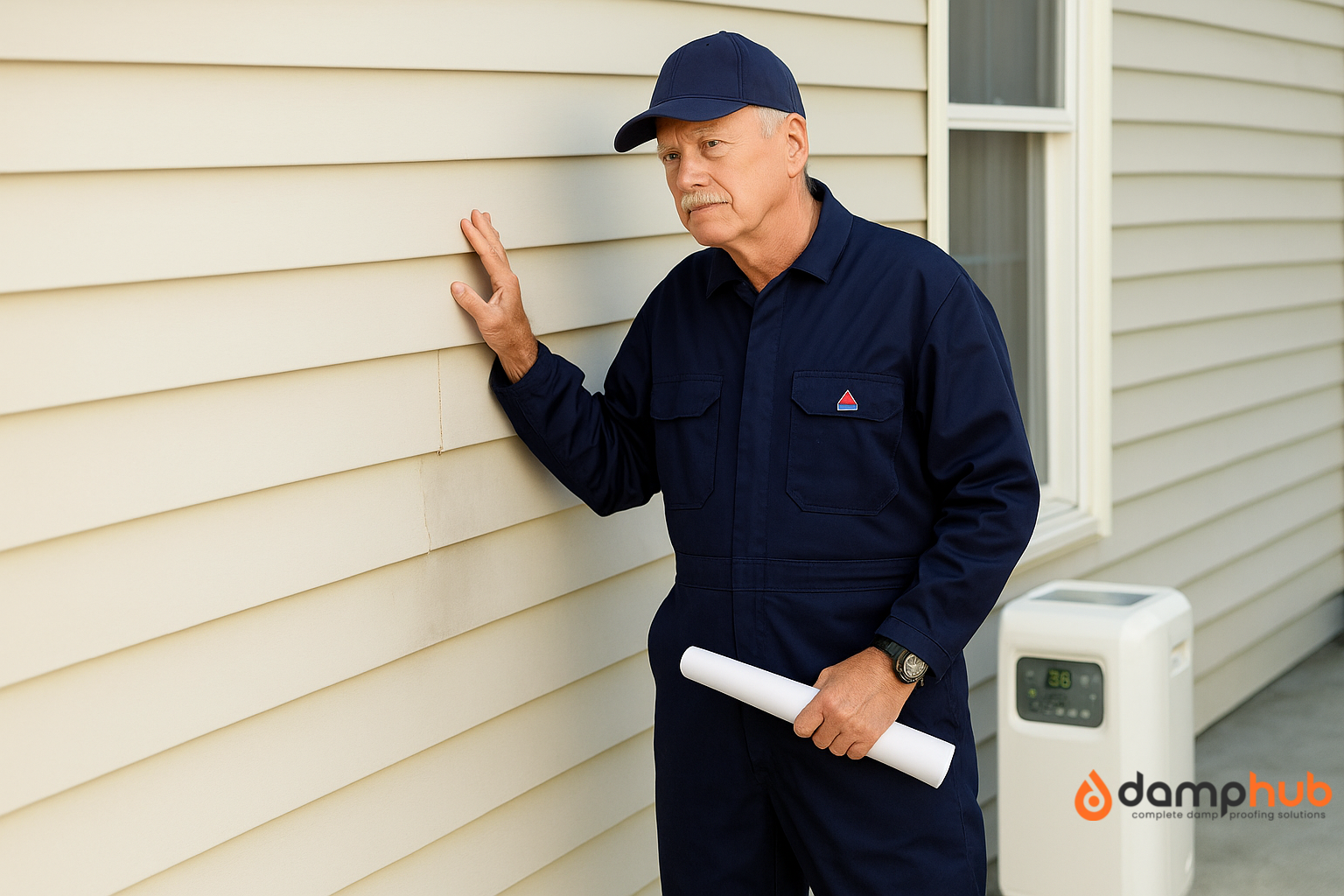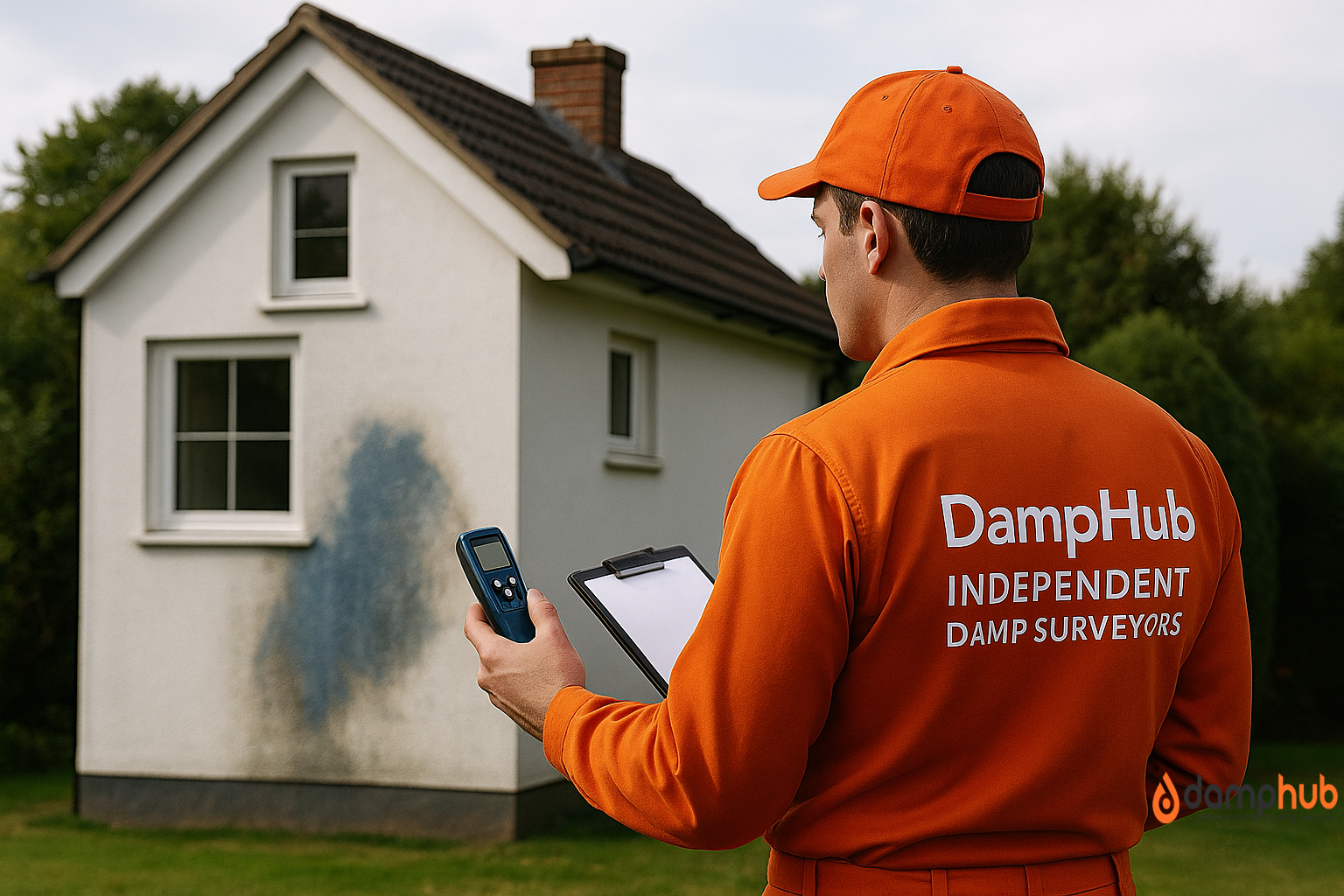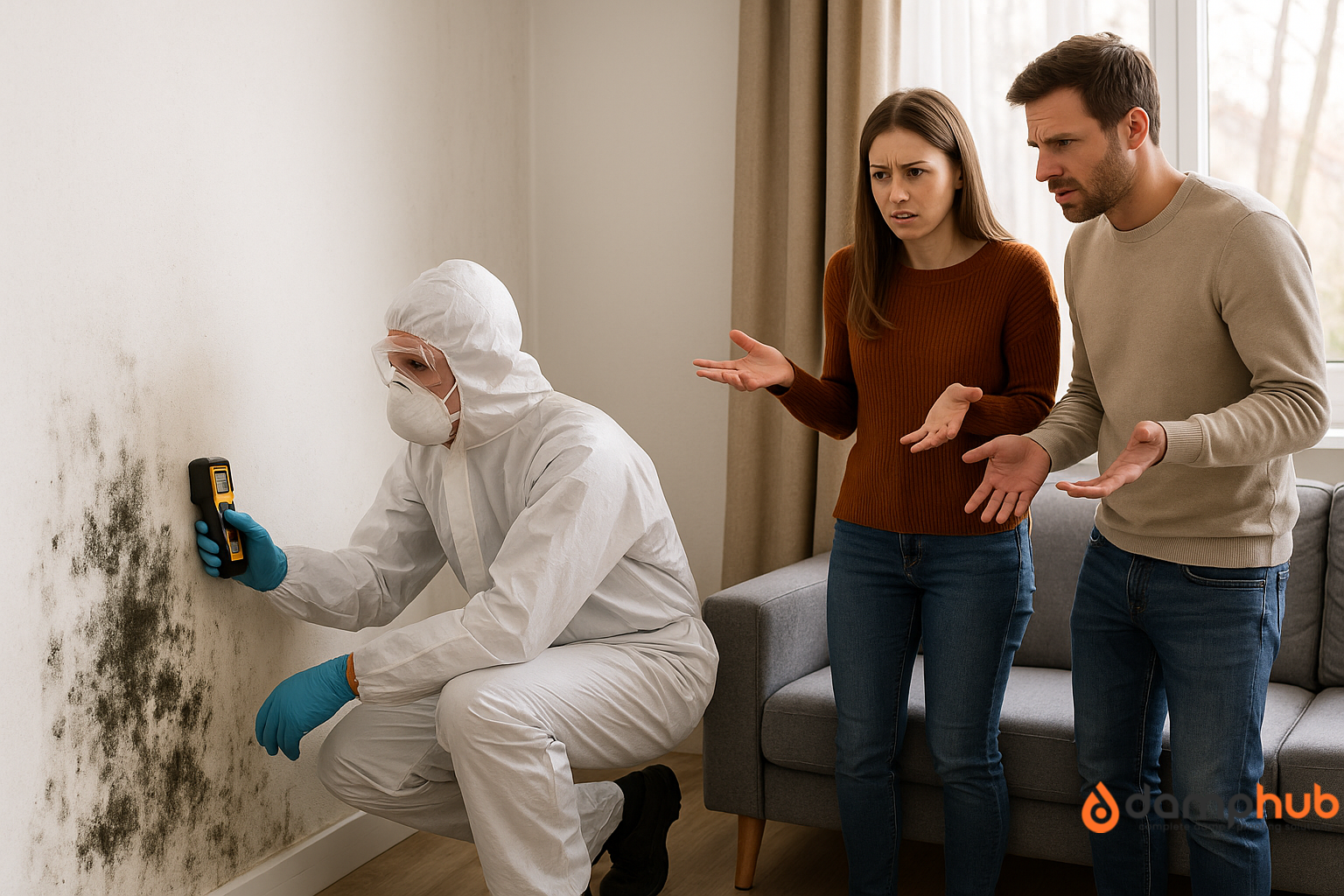
How long does a damp survey take? It takes around three to four hours.
If you’re noticing signs like peeling paint, mould patches, or that tell-tale musty smell, a damp survey can help you unmask the underlying issues.
But how long does a damp survey take, and what happens during one?
This guide breaks down the full timeline, what to expect, and why it’s worth having a damp survey carried out by professionals.
Whether you’re buying a property, renovating, or just want peace of mind, understanding the process helps you take action with confidence.
👉 Must Read: How Do I Choose a Damp Surveyor?
What Happens on a Damp Survey?
A professional damp survey isn’t just a quick visual scan.
It’s a structured investigation that aims to identify the root causes of moisture-related issues within a property.
A qualified surveyor will assess your home using a mix of inspection techniques and diagnostic tools, combining practical experience with scientific data.
Damp surveys are typically divided into five core stages:
- Initial consultation and property background
- External inspection
- Internal investigation
- Diagnosis and discussion
- Report preparation
How long does a damp survey take? In total, the on-site portion takes between 2 to 4 hours, depending on the size, age, and complexity of the property. The full process, including report delivery, is usually completed within 1 to 3 working days.
Let’s walk through each step in detail.
1. Initial Consultation & Background Assessment (15–30 minutes)
Before any tools come out, a qualified surveyor starts with a short consultation.
This stage lays the foundation for the entire survey and helps tailor the inspection to your property’s specific risks and symptoms.
During this step, the surveyor will:
- Ask about previous damp issues or treatments
- Review recent renovations or structural changes
- Note any visible signs such as discolouration, flaky paint, or mould
- Assess ventilation practices and heating usage
This discussion might seem brief, but it’s essential. It ensures the survey isn’t a generic checklist, but a focused investigation that reflects the property’s unique history and usage patterns.
2. External Inspection (30–60 minutes)
Damp rarely starts inside the home—it typically begins with water entering from the outside. That’s why a full external inspection is a core part of every professional damp survey.
The surveyor will walk around the property and assess:
- Brickwork and render: Looking for cracks, gaps, and signs of spalling or porous materials.
- Roofline components: Checking gutters, downpipes, flashing, and chimney stacks for defects.
- Windows and doors: Evaluating the sealant, sills, and pointing for leaks or weaknesses.
- Drainage and ground levels: Observing whether surface water is flowing towards the structure.
- Vegetation: Trees, plants, or roots near the walls can introduce or retain moisture.
This stage helps identify structural or environmental factors that allow moisture to enter or persist around the building.
It also gives context to any internal symptoms, linking external causes with internal outcomes.
👉 Also Read: How to Hire an Independent Damp Specialist in London

3. Internal Inspection (1–2 hours)
Once external risks have been logged, the surveyor moves indoors. This is the most detailed part of the survey, focusing on visible damage and hidden damp sources using a range of tools.
Areas surveyed include:
- Bathrooms, kitchens, and utility rooms: High moisture areas are scrutinised for condensation, poor ventilation, or water ingress.
- Basements and ground floors: These are often most vulnerable to rising damp and require specific checks.
Bedrooms and loft spaces: Cold bridging and condensation are common in upper areas with poor insulation.
Techniques and tools may include:
- Moisture meters: Used to detect damp within walls, floors, or ceilings.
- Hygrometers: Measure air humidity and dew points, indicating condensation risks.
- Thermal imaging cameras: Reveal cold spots that suggest poor insulation or hidden leaks.
Salt analysis: Helps distinguish between rising damp and other moisture types.
The surveyor looks for tell-tale signs such as:
- Black mould spots and condensation trails
- Peeling wallpaper or blistered paint
- Crumbling plaster or tide marks on walls
- Musty odours and stained ceilings
This stage is what defines a good damp survey—it doesn’t just confirm there’s damp, it categorises the type: rising damp, penetrating damp, condensation, or a combination of all three.

4. Diagnosis and Recommendations (30–60 minutes)
Once the internal and external inspections are complete, the surveyor compiles and cross-references their findings to pinpoint the cause of the damp.
They’ll analyse:
- Moisture level patterns
- Environmental and structural risks
- Signs of recurring condensation
- The effectiveness of ventilation systems
- The condition of damp-proof courses or membranes
Then, they’ll walk you through their initial findings in plain terms. This includes:
- A diagnosis of the problem
- Severity of the issue
- Clear, actionable advice on repairs and improvements
This is the moment many homeowners find most valuable. Instead of speculation or guesswork, you’re given evidence-based insights into what’s wrong and how to fix it.
Some surveyors may also provide cost guidance or refer you to qualified contractors, though this depends on whether they are independent or linked to a treatment firm.
5. Damp Survey Report (Delivered in 1–2 working days)
The final stage happens off-site, where the surveyor compiles all findings into a formal written report. Depending on the service, this may be delivered via email, post, or both.
A high-quality damp survey report typically includes:
- A full breakdown of each room or area inspected
- Moisture readings and photographic documentation
- Thermal images (if applicable)
- Diagnosis of damp type(s) present
- External risks and structural observations
- Treatment recommendations (ventilation, DPC repair, insulation, etc.)
- Preventive advice to avoid recurrence
For homeowners, landlords, buyers, or sellers, this report is essential. It allows you to:
- Obtain accurate quotes for work
- Use it as supporting evidence in legal or insurance matters
- Make informed property purchasing or renovation decisions
Mortgage lenders often require a detailed report if damp was noted on a homebuyer survey, making this stage a critical part of the overall timeline.
👉 Related Blog: Who Should Pay for a Damp and Timber Report?
Summary: How Long Do Damp Surveys Take?
Here’s a quick overview of the time commitments involved:
| Survey Stage | Estimated Duration |
|---|---|
| Initial Consultation | 15–30 minutes |
| External Inspection | 30–60 minutes |
| Internal Investigation | 1–2 hours |
| On-Site Diagnosis | 30–60 minutes |
| Report Preparation | 1–2 working days (off-site) |
Total time on-site: 2 to 4 hours
Report delivery: 1 to 3 days after inspection
For most standard homes, the full process fits within this timeframe. Larger or more complex properties may take slightly longer, but this is always discussed in advance.
Is It Worth Paying for a Damp Survey?
If you’re asking this question, you’re already in the right mindset.
And the answer is a strong yes.
Here’s why:
👉 Must Read: Is It Worth Paying for a Damp Survey?
1. Prevent Escalating Costs
Damp problems rarely stay the same—they spread. A small issue with guttering or condensation today can become a full structural issue tomorrow.
Early detection keeps repair costs manageable.
2. Protect Your Property’s Value
Buyers are cautious about damp.
A property with untreated issues can lose market value or face delayed sales. A damp survey provides credibility and reassurance in property transactions.
3. Protect Your Health
Mould spores and high humidity can cause or worsen respiratory conditions, allergies, and skin irritation.
Children, the elderly, and anyone with asthma are particularly at risk. Identifying the cause of moisture helps protect the health of your household.
4. Plan Repairs Accurately
Rather than relying on guesswork, a damp survey tells you exactly what needs fixing—and what doesn’t.
That avoids unnecessary treatments and ensures your money is spent on the right solutions.
5. Peace of Mind
Even if no significant damp is found, a survey gives you documented assurance that your home is in good condition, or that minor issues are under control.
That peace of mind is often worth the cost alone.
When Should You Book a Damp Survey?
A damp survey is advisable in any of the following situations:
- You notice visible signs of damp, mould, or musty odours
- You’re buying a home and want to check for hidden issues
- A mortgage lender or homebuyer survey recommends it
- You’re preparing a property for sale or rent
- You’ve had previous damp treatments, but the issue has returned
Final Thoughts: How Long Does a Damp Survey Take?
If you’ve been wondering how long does a damp survey take, the answer is simple: 3 to 4 hours, followed by a detailed report within a couple of days.
But the value it delivers goes far beyond time.
Understanding what happens on a damp survey equips you to spot potential problems, avoid costly repairs, and take control of your property’s condition.
And when you consider the health risks, structural concerns, and long-term financial costs of ignoring damp, the question “Is it worth having a damp survey?” answers itself.
It’s not just worth it—it’s essential.
✅ Need an Independent Damp Surveyor in Your Area?
Get a free, no-obligation quote from qualified professionals near you. Avoid guesswork—get answers.
FAQs
What happens on a damp survey?
A damp surveyor visits your property to identify signs of moisture, measure damp levels, and find the root cause. They use tools like moisture meters, thermal imaging cameras, and salt tests.
The inspection covers walls, floors, ceilings, and potential sources such as leaking pipes, faulty gutters, or poor ventilation. After the visit, you receive a detailed report with findings, recommended treatments, and cost estimates.
What to do before a damp survey?
Clear access to affected walls, corners, or areas behind furniture so the surveyor can inspect thoroughly.
Make a note of any past issues, leaks, or repairs.
Ensure rooms are ventilated, and avoid cleaning or painting over damp patches before the visit, as this can hide evidence.
If possible, collect photos or documents related to previous damp problems.
Who pays for a damp survey?
The person commissioning the survey usually pays. For homeowners, this is often the buyer or seller during property transactions.
In rental situations, landlords generally cover the cost when damp affects living conditions or health.
Always clarify in advance who’s responsible, especially if the issue is disputed. For more information, read our full guide Who should pay for a damp and timber report?
What to do if a surveyor finds damp?
Read the report carefully to understand the damp type, location, and cause. Prioritise fixing the source—whether it’s a leak, blocked gutter, or poor ventilation.
Get 2–3 repair quotes for comparison. Avoid cosmetic fixes without addressing the root problem, as damp will return.
If you’re a tenant, report the findings to your landlord immediately.
Can you hide damp from a surveyor?
Temporarily, yes—but it’s not advisable.
Painting over stains, using dehumidifiers right before the visit, or masking smells may disguise symptoms briefly, but professional surveyors use tools that detect moisture beneath the surface.
Concealing damp can lead to legal or financial issues during a sale or tenancy dispute.
Do surveyors check every wall for damp?
Not always, but they focus on high-risk and visible areas.
This includes exterior-facing walls, corners behind furniture, ceilings, skirting boards, and areas where signs like mould or peeling paint are present.
If full access is granted, most good surveyors will check all accessible walls to ensure no damp is missed.
What causes high damp readings on surveys?
High readings are often due to water ingress from leaks, rising damp, poor ventilation, or condensation.
External sources like blocked gutters or cracked render can also push moisture into walls.
Internally, drying clothes indoors or lack of airflow in kitchens and bathrooms can spike humidity levels.
False positives may occur on new plaster or recent rainfall, so readings must be interpreted carefully.
How does a damp test work?
Damp tests involve measuring moisture content within building materials using a moisture meter.
Surveyors may also perform salt analysis to distinguish rising damp from other causes and use thermal cameras to detect hidden moisture or cold spots.
Some cases require invasive testing like drilled probes or core sampling.
What if damp is not picked up on survey?
If damp appears after a survey but wasn’t reported, it may have been missed due to limited access or developing issues post-inspection.
Always review the surveyor’s disclaimers.
If negligence is suspected, you can seek a second opinion and, in serious cases, make a formal complaint to their governing body or pursue compensation.
What level of damp is acceptable?
Moisture readings below 15% are generally safe. Levels between 16–20% may indicate early signs of damp.
Readings over 20% usually confirm a problem. Acceptable levels vary depending on material (e.g., plaster vs. brick) and environmental conditions.
An experienced surveyor will explain whether your readings are normal, borderline, or cause for concern.






